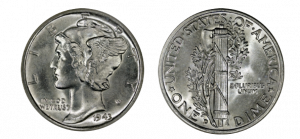The Mercury Dime: Liberty of Thought
Posted onThe Mercury dime, struck from 1916 to 1945, gets its unusual name from its depiction of a young Liberty. Her image on the obverse shows her wearing a winged Phrygian cap which gives her a look similar to that of the Roman god Mercury.
While the model used as inspiration for the design is unknown, many believe that Elsie Stevens, the wife of American poet Wallace Stevens, served as the basis for the image. The design is the work of German-born American sculptor Adolph Weinman. He was selected for the design work after winning a competition with two other sculptors. Though the imagery was well-received, minor modifications were required to get the coin to work with vending machines of the time. AT&T also warned officials that the original coins were too thick to work in their pay phones.
Weiman’s motivation for the famous winged cap was to express “liberty of thought”. Others suggest that Weiman crafted this design simply because he liked the look of feathers in relief. The reverse of the coin shows a fasces which is a bound bundle of wooden rods. Traditionally, this image is intended to represent a magistrate’s power and jurisdiction. Weiman’s intent was to use the image to represent war and justice.
The first Mercury dimes entered circulation in October 1916. The design received nearly universal praise. The mint continued to strike the coin until 1930 with a pause in 1922 due to an economic downturn.
Today, there are a few Mercury coin mintings that are particularly sought after. One example is the 1916-D issuance struck at the Denver Mint. Only 264,000 were minted because officials had to pause their minting when an unusually large order for quarters had to be fulfilled. This relatively low number of Mercury coins makes that particular issuance somewhat rare.
Another unusual minting is the 1942/41 overdate which is a double die error. The obverse die used had one impression from a 1942 hub and one from a 1941 hub. As a result, the date 1942 on the obverse also has a “1” appearing over the “2.” The error is easy to spot as the date appears to have five digits instead of four.
The 1945-S variety is also an outlier. The coin has an abnormally small mint mark. This error was the result of the mint having to resort to different equipment stemming from wartime resource demands.
The rarest Mercury dimes were those that were flown into space aboard the Mercury-Redstone 4 sub-orbital mission on July 21, 1961. This was the second US human space flight. The coins ultimately sank with the capsule in the Atlantic Ocean but were recovered from the ocean floor in 1999.
The US Mint also released a gold 2016 centennial version of the Mercury dime. The coin was so popular that they were sold out within 45 minutes of its release.
Today, the coins are still appreciated for their unique design and unusual journey into space and into the depths of the ocean.
Want to read more? Subscribe to the Blanchard Newsletter and get our tales from the vault, our favorite stories from around the world and the latest tangible assets news delivered to your inbox weekly.









